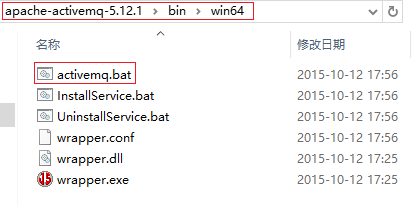应用场景
随着项目的逐渐扩大,日志的增加也变得更快。Log4j是常用的日志记录工具,在有些时候,我们可能需要将Log4j的日志发送到专门用于记录日志的远程服务器,特别是对于稍微大一点的应用。这么做的优点有:
-
可以集中管理日志:可以把多台服务器上的日志都发送到一台日志服务器上,方便管理、查看和分析
-
可以减轻服务器的开销:日志不在服务器上了,因此服务器有更多可用的磁盘空间
-
可以提高服务器的性能:通过异步方式,记录日志时服务器只负责发送消息,不关心日志记录的时间和位置,服务器甚至不关心日志到底有没有记录成功
远程打印日志的原理:项目A需要打印日志,而A调用Log4j来打印日志,Log4j的JMSAppender又给配置的地址(ActiveMQ地址)发送一条JMS消息,此时绑定在Queue上的项目B的监听器发现有消息到来,于是立即唤醒监听器的方法开始输出日志。
本文将使用两个Java项目Product和Logging,其中Product项目就是模拟线上的项目,而Logging项目模拟运行在专用的日志服务器上的项目。说明:本文的例子是在Windows平台下。
安装ActiveMQ
1. 下载:http://activemq.apache.org/download.html
2. 解压后不需要任何配置,进入到bin下对应的系统架构文件夹

3. 双击activemq.bat启动,如果看到类似下面的页面,就代表activemq启动好了:

然后打开浏览器,输入地址:http://localhost:8161进入管理页面,用户名admin,密码admin:

可以点击Manage ActiveMQ broker进入Queue的查看界面。
实战
我用Maven来管理项目,方便维护各种依赖的jar包。先看下项目结构:

项目不复杂,主要是4个文件:pom.xml,Main.java,log4j.properties和jndi.properties
pom.xml中主要是声明项目的依赖包,其余没有什么东西了:
<!-- Use to call write log methods -->
<dependency> <groupId>log4j</groupId> <artifactId>log4j</artifactId> <version>1.2.17</version> </dependency> <!-- Log4j uses this lib --> <dependency> <groupId>org.slf4j</groupId> <artifactId>slf4j-log4j12</artifactId> <version>1.7.13</version> </dependency> <!-- Spring jms lib --> <dependency> <groupId>org.springframework</groupId> <artifactId>spring-jms</artifactId> <version>4.0.0.RELEASE</version> </dependency> <!-- ActiveMQ lib --> <dependency> <groupId>org.apache.activemq</groupId> <artifactId>activemq-core</artifactId> <version>5.7.0</version> </dependency>Main.java:
package com.demo.product;
import javax.jms.Connection;
import javax.jms.Destination;
import javax.jms.Message; import javax.jms.MessageConsumer; import javax.jms.MessageListener; import javax.jms.Session; import org.apache.activemq.ActiveMQConnectionFactory; import org.apache.activemq.command.ActiveMQObjectMessage; import org.apache.log4j.Logger; import org.apache.log4j.spi.LoggingEvent; public class Main implements MessageListener { public Main() throws Exception { // create consumer and listen queue ActiveMQConnectionFactory factory = new ActiveMQConnectionFactory("tcp://localhost:61616"); Connection connection = factory.createConnection(); Session session = connection.createSession(false, Session.AUTO_ACKNOWLEDGE); connection.start(); //////////////注意这里JMSAppender只支持TopicDestination,下面会说到//////////////// Destination topicDestination = session.createTopic("logTopic"); MessageConsumer consumer = session.createConsumer(topicDestination); consumer.setMessageListener(this); // log a message Logger logger = Logger.getLogger(Main.class); logger.info("Info Log."); logger.warn("Warn Log"); logger.error("Error Log."); // clean up Thread.sleep(1000); consumer.close(); session.close(); connection.close(); System.exit(1); } public static void main(String[] args) throws Exception { new Main(); } public void onMessage(Message message) { try { // receive log event in your consumer LoggingEvent event = (LoggingEvent)((ActiveMQObjectMessage)message).getObject(); System.out.println("Received log [" + event.getLevel() + "]: "+ event.getMessage()); } catch (Exception e) { e.printStackTrace(); } } }说明:然后是log4j.properties:
log4j.rootLogger=INFO, stdout, jms
## Be sure that ActiveMQ messages are not logged to 'jms' appender
log4j.logger.org.apache.activemq=INFO, stdout log4j.appender.stdout=org.apache.log4j.ConsoleAppender log4j.appender.stdout.layout=org.apache.log4j.PatternLayout log4j.appender.stdout.layout.ConversionPattern=%d %-5p %c - %m%n ## Configure 'jms' appender. You'll also need jndi.properties file in order to make it work log4j.appender.jms=org.apache.log4j.net.JMSAppender log4j.appender.jms.InitialContextFactoryName=org.apache.activemq.jndi.ActiveMQInitialContextFactory log4j.appender.jms.ProviderURL=tcp://localhost:61616 log4j.appender.jms.TopicBindingName=logTopic log4j.appender.jms.TopicConnectionFactoryBindingName=ConnectionFactory其实按理说只需要这么三个文件就可以了,但是这时候执行会报错:
javax.naming.NameNotFoundException: logTopic at org.apache.activemq.jndi.ReadOnlyContext.lookup(ReadOnlyContext.java:235) at javax.naming.InitialContext.lookup(Unknown Source) at org.apache.log4j.net.JMSAppender.lookup(JMSAppender.java:245) at org.apache.log4j.net.JMSAppender.activateOptions(JMSAppender.java:222) at org.apache.log4j.config.PropertySetter.activate(PropertySetter.java:307) ... at org.apache.activemq.ActiveMQPrefetchPolicy.<clinit>(ActiveMQPrefetchPolicy.java:39) at org.apache.activemq.ActiveMQConnectionFactory.<init>(ActiveMQConnectionFactory.java:84) at org.apache.activemq.ActiveMQConnectionFactory.<init>(ActiveMQConnectionFactory.java:137) at com.demo.product.Main.<init>(Main.java:20) at com.demo.product.Main.main(Main.java:43)为什么会报错呢?来看看JMSAppender的javadoc文档,它是这么描述的:

大意是说,JMSAppender需要一个jndi配置来初始化一个JNDI上下文(Context)。因为有了这个上下文才能管理JMS Topic和topic的连接。于是为项目配置一个叫jndi.properties的文件,其内容为:
topic.logTopic=logTopic然后再运行就不会报错了。我们先来看看ActiveMQ(注意切换到Topic标签页下):

可以看到,主题为logTopic的消息,有3条进Queue,这3条也出Queue了。而出Queue的消息,已经被我们的监听器收到并打印出来了:

Spring整合
需要注意的是,本例只是一个很简单的例子,目的是阐明远程打印日志的原理。实际项目中,一般日志服务器上运行着的,不是项目,而是专用的日志记录器。下面,我们就把这个项目拆分成两个项目,并用Spring来管理这些用到的Bean
修改Product项目
修改后的Product的项目结构并没有改变,改变的只是Main类:
package com.demo.product;
import org.apache.log4j.Logger;
public class Main{ private static final Logger logger = Logger.getLogger(Main.class); public static void main(String[] args) throws Exception { // just log a message logger.info("Info Log."); logger.warn("Warn Log"); logger.error("Error Log."); System.exit(0); } }这个Main类和普通的logger调用一样,仅仅负责打印日志。有没有觉得太简单了呢?
Logging项目
来看看项目结构图:

为了让监听器一直活着,我把Logging写成了一个Web项目,跑在Tomcat上。index.jsp就是个Hello World字符串而已,用来验证Logging活着。注意,在Logging项目中,已没有Product项目中的log4j.properties和jndi.properties两个文件。
来看看另外几个文件:
pom.xml(每个包的目的都写在注释里了):
<!-- Use to cast object to LogEvent when received a log -->
<dependency> <groupId>log4j</groupId> <artifactId>log4j</artifactId> <version>1.2.17</version> </dependency> <!-- Use to receive jms message --> <dependency> <groupId>org.springframework</groupId> <artifactId>spring-jms</artifactId> <version>4.0.0.RELEASE</version> </dependency> <!-- Use to load spring.xml --> <dependency> <groupId>org.springframework</groupId> <artifactId>spring-web</artifactId> <version>4.0.0.RELEASE</version> </dependency> <!-- ActiveMQ lib --> <dependency> <groupId>org.apache.activemq</groupId> <artifactId>activemq-core</artifactId> <version>5.7.0</version> </dependency>web.xml
<!DOCTYPE web-app PUBLIC
"-//Sun Microsystems, Inc.//DTD Web Application 2.3//EN"
"http://java.sun.com/dtd/web-app_2_3.dtd" >
<web-app> <context-param> <param-name>contextConfigLocation</param-name> <param-value>classpath:spring.xml</param-value> </context-param> <!-- Use to load spring.xml --> <listener> <listener-class> org.springframework.web.context.ContextLoaderListener </listener-class> </listener> <welcome-file-list> <welcome-file>index.jsp</welcome-file> </welcome-file-list> </web-app>spring.xml
<?xml version="1.0" encoding="UTF-8"?> <beans xmlns="http://www.springframework.org/schema/beans" xmlns:xsi="http://www.w3.org/2001/XMLSchema-instance" xsi:schemaLocation=" http://www.springframework.org/schema/beans http://www.springframework.org/schema/beans/spring-beans-4.0.xsd"> <bean id="jmsTemplate" class="org.springframework.jms.core.JmsTemplate"> <property name="connectionFactory" ref="connectionFactory"/> </bean> <bean id="connectionFactory" class="org.springframework.jms.connection.SingleConnectionFactory"> <property name="targetConnectionFactory" ref="targetConnectionFactory"/> </bean> <bean id="targetConnectionFactory" class="org.apache.activemq.ActiveMQConnectionFactory"> <property name="brokerURL" value="tcp://localhost:61616"/> </bean> <!-- As JMSAppender only support the topic way to send messages, thus queueDestination here is useless. <bean id="queueDestination" class="org.apache.activemq.command.ActiveMQQueue"> <constructor-arg name="name" value="queue" /> </bean> --> <bean id="topicDestination" class="org.apache.activemq.command.ActiveMQTopic"> <constructor-arg name="name" value="logTopic" /> 






 本文介绍如何使用Spring、Log4j和ActiveMQ实现远程日志记录。通过实例演示了如何配置ActiveMQ,搭建Product和Logging两个项目,实现日志的远程发送与接收。
本文介绍如何使用Spring、Log4j和ActiveMQ实现远程日志记录。通过实例演示了如何配置ActiveMQ,搭建Product和Logging两个项目,实现日志的远程发送与接收。
















 3796
3796

 被折叠的 条评论
为什么被折叠?
被折叠的 条评论
为什么被折叠?








